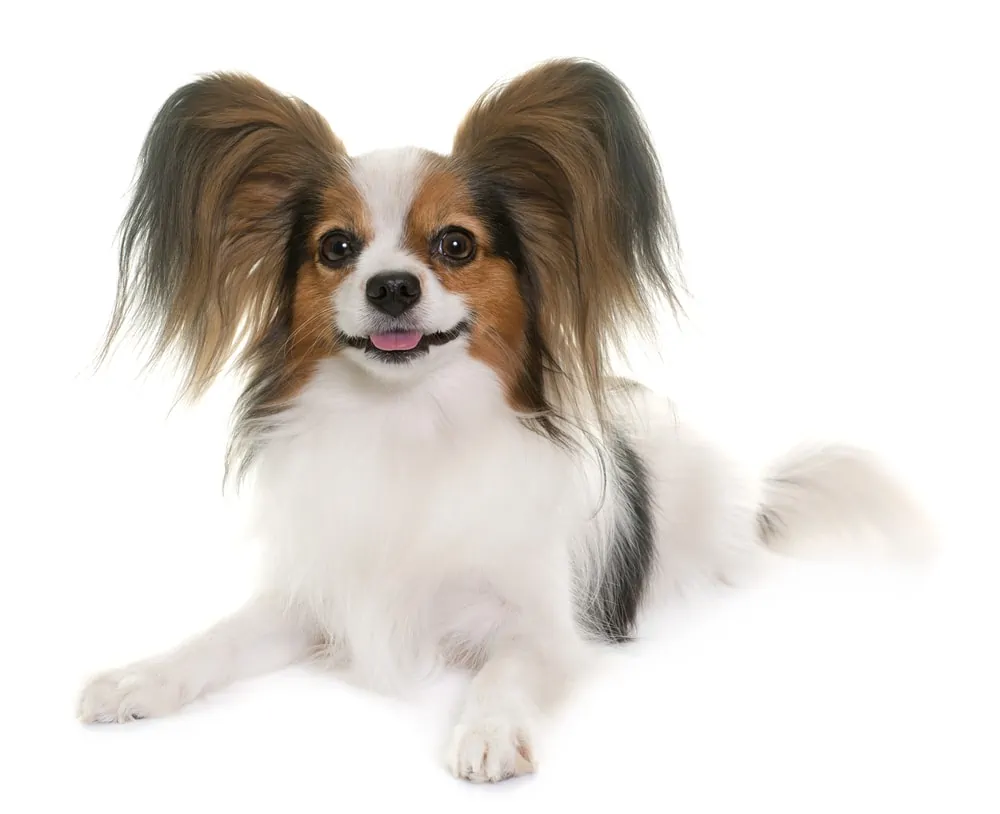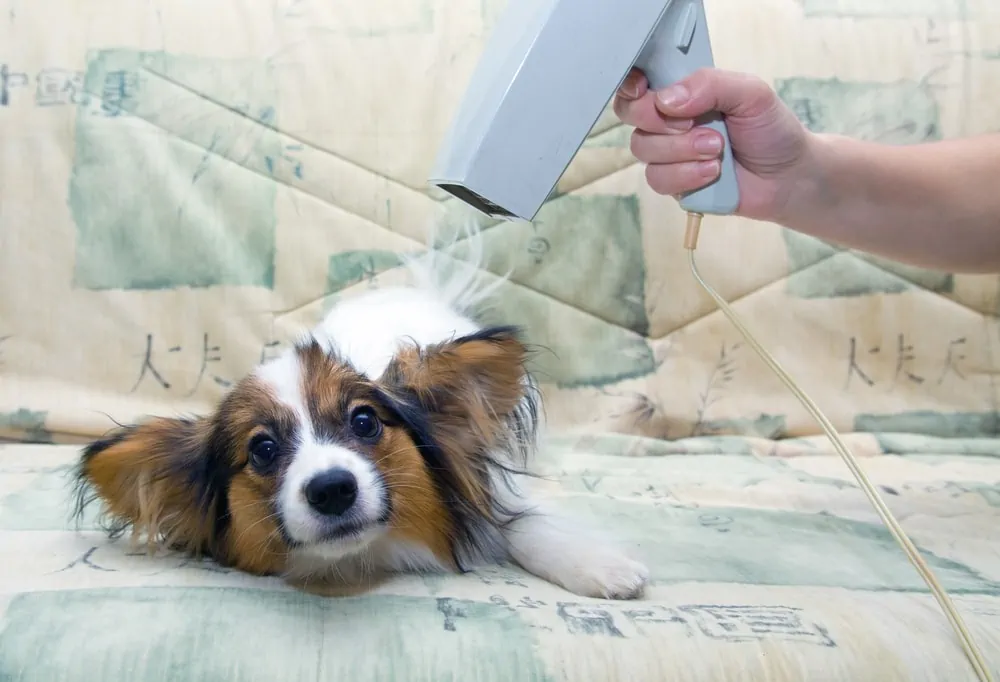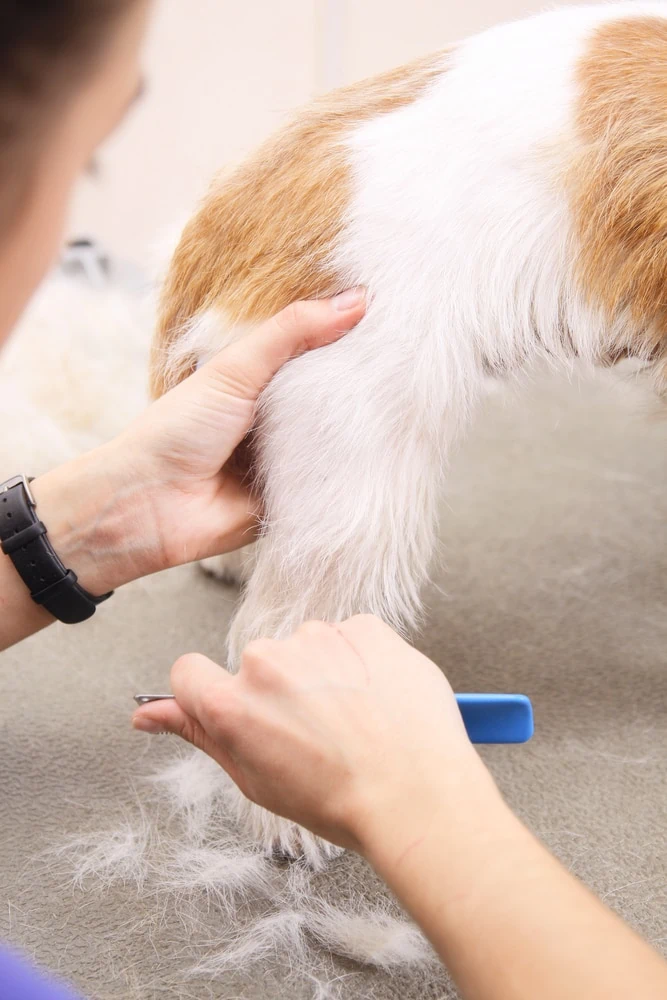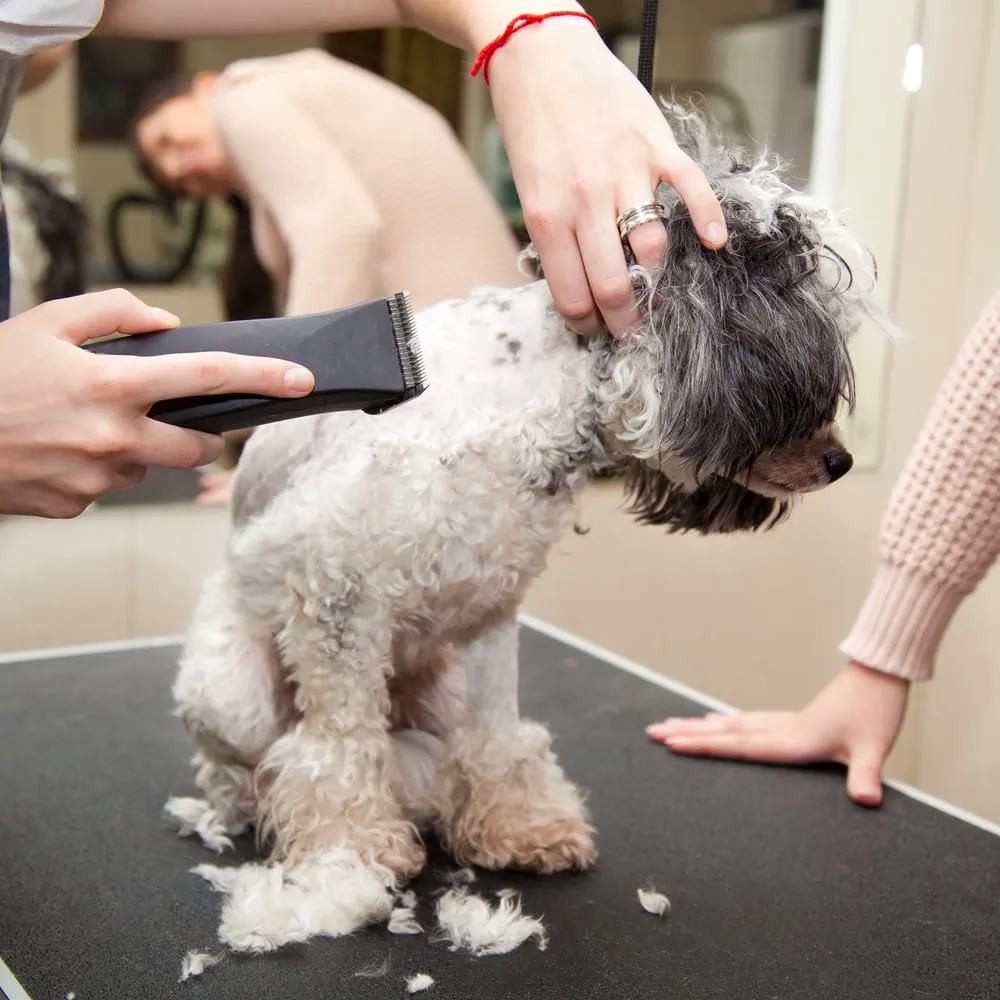When summer approaches, many dog owners look at their panting pets and wonder how they can make them a little more comfortable.
You might be one of those owners, as you watch your papillon brave the summer heat. With his thick long coat, you wonder if shaving him is a good idea in hot weather.
While many pet owners think that shaving their pet is the best way to keep them cooler, there is a lot more to think about.
Less hair does not necessarily equal a lower body temperature and in some cases, can actually be more harmful to your pet.
What is a shaved papillon? A shaved papillon is a toy dog breed that has had all or most of its hair removed. A papillon is a Spaniel breed dog, also known as a Continental Toy Spaniel. Papillon is the French word for butterfly and the dog is aptly named due to the long hair it has on its ears and facial markings that imitate the appearance of an insect’s body, giving it a butterfly-like appearance.
The Papillon has a long coat of hair that requires daily brushing, which also might encourage some owners to clip or shave the dog’s hair (source). However, you may want to think about the following before you pick up the clippers.
History of the Papillon

The first example of the continental toy spaniel emerged in painting from Old Masters, like Titian, back in the 16th Century.
The Papillon, as we know it today, only emerged a few centuries later due to its popularity in royal courts. Through breeding, the toy spaniel was developed with a more refined bone structure, along with a thicker coat and feathering of the hair on the ears.
The changes through breeding also brought about a change in the shape of the head, changing from flat to high-domed, and the ears that became more erect, leading to the name Papillon.
The toy spaniel has also gone through several color changes over the years, from the fashionable almost solid color back to the evenly marked parti-color that papillons are known for now (source).
The papillon is a native breed of both France and Belgium and has continued to thrive in the United States, where is it ranked 54 out of 193 breeds (source).
Physical Aspects of the Papillon
The Papillion is known for its beautiful coat and unique feathered fur, and it is also a loving and friendly dog.
Height and Weight
A papillon is about 8-11 inches (20-28cm) tall and weighs between 7-9 pounds (3-4 kg).
Head
The papillon has a rounded head with an alert expression. The nose is black with a flat top and rounded front. It has medium-sized dark eyes and the ears are large with rounded tips and set on the side of the head.
Some papillons have dropped ears which droop and these are known as Phalene (French for moth).
Body
The body is proportionally longer than the papillon’s height and the dog carries it erect with the stomach tucked in.
Legs and Feet
The legs are considered to be thin and fine-boned. The papillon’s feet resemble a rabbit’s and face forward
Coat
The papillon does not have an undercoat. The hair on the back and sides of the body should be thick, silky and flowing. It has shorter hair on its head, with the exception of the ears. The tail is often described as a plume, which should be long and jaunty.
Color
The coat of the papillon is usually a mix of colors, with white being the primary color.
The ears and area above the eyes should always be some other color, as no papillon is purely white. The markings on the face should also be symmetrical. (source)
Caring for a Papillon’s Coat

Since the dog is best known for its fur, it is vital for an owner to know exactly how to groom their dog, for aesthetic purposes and more importantly, for the dog’s health and well-being.
Features of the Coat
Papillon dogs are characterized by their long, soft coats that are mainly white with different color segments (source). This sort of color pattern is referred to as being parti-color (source).
These colored patches differ to such a degree from dog to a dog that it is said that no two papillons are exactly identical (source).
The health of dogs can be seen through the quality of their coats as a poor diet or internal/external factors can have a negative impact on the dogs’ fur (source).
Shedding and Grooming
Papillon coats are fairly low maintenance, with special attention and grooming needed only to the delicate hair of their ear fringe it is most notable for.
While these dogs enjoy having proper hygiene most dirt and plant matter can be removed simply through the stroke of a brush. It is encouraged to brush dogs of this breed on a daily basis.
The easy cleaning process also means that these dogs do not have a bad body odor and when bathing is necessary it can be done either with water and normal shampoo or dry shampoo. Papillons, in fact, do not need to be bathed very often by all accounts.
These dogs also have no undercoat (source). This lack of double-coating means that there is little to no seasonal shedding.
They share this characteristic with their furry toy dog cousins, the Silverback Yorkie – you can read more about Silverback Yorkies in an additional article. Otherwise, papillons shed only an average amount.
Nails and Teeth
Their nails need to be clipped occasionally and their teeth must be cleaned frequently due to tartar build-up.
Papillon’s teeth should be brushed at least twice a week but every day is encouraged with enzymatic pet toothpaste so as to prevent gum disease, bad breath and other kidney and heart diseases (source). Dry dog food can also be used to lessen tartar build-up.
Nails that are not trimmed or improperly trimmed can be damaging as it can change the shape of the dog’s foot and at times cause discomfort to the papillon (source). This easy grooming process makes them popular choices to exhibit in dog shows by beginner owners/competitors.
How to Groom a Papillon
A papillon should be brushed daily with a pin-style brush. This ensures that there is the minimal tangling of the fur and it also removes dead skin cells.
If matting or tangling is found, the easiest way to undo this would be to separate the tangle from the rest of the coat and slowly brush out small sections of the matting without damaging the fur. Under no circumstances should the fur be cut. (source)
When it comes to the ear fringe, a mix of conditioner and water can be used to keep the fur moisturized and it assists with detangling (source).
Papillons should be bathed on a weekly basis, along with nail shortening and the removal of excess hair on the feet. Nails can be cut with a trimmer or using a specialized nail file. Hair between the pads should be cut carefully using a sharp pair of scissors (source).
When blow-drying the papillon’s hair, the warm air should go in the direction of the hair and not look unnaturally fluffy. Drying the ears should follow a similar direction and the hair should be brushed out gently. (source)
Why Would You Shave a Papillon?
Papillon dogs do not need their hair trimmed, for the most part only their feet are trimmed by owners who wish to showcase them in dog shows (therefore for aesthetic reasons). This however also has a minor benefit as it causes the dogs to drag in less dirt from the outside environment.
Some owners might feel that the weather is too warm, or they may struggle with keeping their dog groomed. Since papillons are generally low-maintenance unless being shown in dog shows, they should not require a lot more than a weekly brushing, bar the ears.
Weather Concerns
Interestingly enough, it is primarily pet owners who do not like the idea of shaving dogs, while veterinary professionals are more likely to think that shaving a pet if okay, depending on the weather and the animal’s coat/fur (source).
While one is discouraged to shave their papillon’s fur due to its importance as an insulator for dogs, during heat waves and other warm-weather a trim can make the weather more manageable for the canine (source).
Since a papillon does not have an undercoat, it means that its coat is perfect for allowing cool air to reach the skin without the barrier of an undercoat.
The longer hairs provide protection against the sun and they are vital for keeping your beloved dog cool (source). Therefore, unless there is a specific reason to shave your dog, it should be avoided.
Hot Spots
Hot spots are a common skin condition on dogs. They are most likely to appear during summer months due to the heat and they show up as painful sores on the dog’s body. Basically, hot spots are a form of skin inflammation and bacterial infection (source).
Like humans who scratch themselves when itchy, dogs do the same. However, they do not have the self-control to stop scratching and the constant friction can lead to hot spots on the skin.
There are various reasons for scratching in dogs, including but not limited to: parasites, fleas, skin infections, a dirty coat or a coat that has not dried fully after bathing or swimming (source).
Cleanliness in dogs is vital to maintain a healthy coat and in a case where the owner is unable to look after the dog’s coat properly, shaving might make grooming easier for both man and beast.
Myiasis
This is a rare but preventable condition that may inflict some dogs with long, matted and unkempt fur. If a long-haired dog is not well-groomed, its fur can become matted and tangled.
This, combined with moistness from rain, puddles or some other source of unclean water, could lead to the growth of maggots in the fur (source).
In this particular situation, it is best for the dog’s health to shave their fur and thoroughly clean the skin and fur. Of course, if there are maggots in an untreated wound, the pet should be taken to the vet right away.
Tips for Shaving your Papillon
If an owner does decide to shave their dog, the following points should be considered:
Professional Grooming
Preferably use a professional dog groomer who understands the needs of specific dogs.
Cool Clippers
Clippers should be kept cool because they can easily become hot after a few minutes of usage. If scissors are used, they should be sharp to avoid unnecessary pulling of the fur.
Take Care
It should be done extremely carefully, taking note to leave an inch or more of fur intact as dogs need the protective layer to avoid sunburn.
Consequences of Shaving
If you do decide to shave, please note the consequences that may be detrimental to your dog’s health.
Sunburn and Heat Stroke
By removing the insulating layers of hair, dogs are more likely to suffer from sunburn when they play or walk in direct sunlight.
Their skin does not have the same temperature-regulating features that human skin has; therefore a shaved dog should be kept indoors or in the shade as much as possible. They should also be given as much drinking water as possible to keep cool (source).
Coat Damage
Generally, there is little to no coating damage when it comes to shaving papillons (source). However, it should be avoided as much as possible. Papillon’s hair after shaving grows back with the same texture as it had previously (source).
This is due to them having a single coat. Double-coated dogs are not as lucky and they do suffer from coat damage and changed texture if they are shaved.
Hair Re-Growth
There is no definitive length of time in which a papillon’s hair will grow back but anecdotal evidence suggests that it will take between a few months to a year for a shaved papillon to return to its flowing beauty. It should also be noted that hair on the ears does take longer to grow out.
Here’s a quick tip on how to groom your Papillon:
Keeping Your Pet Cool in the Summer

Preferably, instead of shaving your pet, there are easier ways to ensure that your papillon remains cool. The following are a few tips on maintaining a comfortable environment for your pet in the summer.
Keep Them in the Shade or Cold
Depending on if your dog is an indoor or outdoor dog, keep them cool by giving them plenty of shade or in a cooler/air-conditioned room (source).
Give Them Plenty of Water
They need water to stay hydrated (source). Leave many different sources of water and add ice to keep the water cool for your pet.
Do Not Let Them Run Around for too Long
Especially not in the midday sun. Plan your walks with your dogs during cooler periods like early morning or in the evening. Similarly, check the temperature of the ground before allowing your dog to walk on hot sidewalks (source).
Never Leave Your Dogs in a Car on a Hot Day
The temperature in cars can soar quickly, leaving your dogs at the risk of fatal heatstroke. Even if the car is parked in the shade or left with windows cracked open, temperatures still increase rapidly. If you have to leave your dog in the car, leave them with the air-conditioning on.
Let Your Dogs Play with Water
Preferably, this should be done in a shallow plastic pool in the garden rather than a full-size pool (source), unless you have taught your dog how to swim to the shallow end and get out. Dogs should be supervised if they do play in the full-size pool.
Keep Your Dogs Well-Groomed
While this does not seem to be the most obvious point on the list, hot spots and matting of moist fur are most likely to happen in summer, therefore it is vital that dogs’ coats be clean and free of knots (source).
Apply Sunscreen to Your Pets’ Noses and Ears
Animals are just as likely to get sunburned as humans, and lighter colored pets are more prone to sunburn. Sunscreen should be applied to any areas that do not have a lot of furs. Sunburn also increases the chance of skin cancer in animals (source).
**Looking for a great dog collar? Find out what suitable collar your dog needs here!**
Final Thoughts
Despite their long hair, papillons do not shed too much and their coat does not require a lot of maintenance. While there are no major repercussions to shaving a papillon, it should only be done as a last resort as the coat provides natural protection against the elements.
A shaved papillon would be a crime against beauty, as its lovely coat is one of the dog’s most appealing features. A papillon is a beautiful and fun-loving dog to have. Despite their dainty and refined appearance, they are just like every loveable dog which wants to jump, play and cuddle.
Your dog will enjoy his summer, romping around the garden in the late afternoon, his ear-fringe blowing in the breeze. He is hairy and happy and all is right in the world.


0 Comments